A Brief Biography of the Artist*
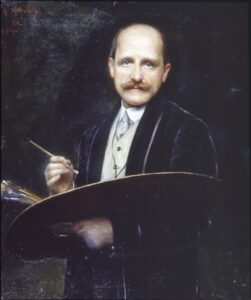
Adolfo Muller-Ury’s 1914 Self Portrait, painted in New York.
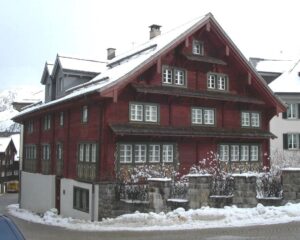
The ancestral house of the Müller family in Hospental, Switzerland, photographed after its recent restoration.
Adolfo Muller-Ury was born Felice Adolfo Müller on 29 March 1862 at Airolo, Switzerland to a prominent patrician family who descended from the von Rechberg family (a lady from which family married a Müller in the early eighteenth century creating a lineage that could be traced back to the Dark Ages) and by the late 18th and early 19th centuries included mercenaries, lawyers, hoteliers and businessmen. Adolfo was the sixth of nineteen children, most of whom survived infancy, born to Roman Catholic parents: Carl Alois (Luigi) Müller (1825–1887), a lawyer, was Gerichtspräsident (Presiding Judge) of the Cantonal Courts, and Genovefa (née Lombardi; 1836–1920), daughter of Felice Lombardi, Director of the Hospice on the St. Gotthard Pass which he took over from the Capuchin monks who had run it for centuries. The family spoke Airolese mainly, a local dialect of Ticinese Italian, as well as Swiss-German, and indeed they lived mainly in Airolo where the artist’s Lombardi grandfather had a huge house and his father Alois Müller practiced law. In 1879 a conflagration in Airolo destroyed the parish church of Santi Nazario e Celso and ‘Luigi Müller’ was largely instrumental in organizing the reconstruction of the church (a plaque commemorating his efforts was placed in the church, but since 1996 has been ignominiously relocated behind the altar). It was in this church that the young Adolfo Müller, his many siblings, his parents and his Lombardi relatives would have worshipped.
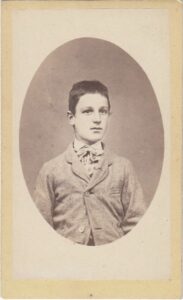
Adolfo Müller as a boy, c. 1875.
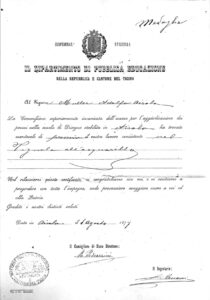
Adolfo Müller’s final certificate in August 1877 from the Ticinese department of public education. The word ‘Medaglia’ is written at the top right.
After attending the municipal drawing school in the Ticino, and the public school in Sarnen (the large building of which still stands in the town) he was encouraged by the sculptor Vincenzo Vela (1820–1891) and possibly the Commendatore Metalli-Stresa (a family friend), to study oil painting under the local painter of religious pictures in a Nazarene-style, Melchior-Paul von Deschwanden in Stans in Switzerland (who died in Adolfo’s arms in February 1881). Deschwanden’s work was very popular in the nineteenth century, but it was not until the autumn of 1933 that a monument in his memory by the Swiss sculptor August Stanser Blaesi (1903–1979) was erected in the front garden of the former Nidwaldner Kantonalbank in the centre of Stans.
On April 25, 1881, he entered the Munich Academy (Register No: 3945) where he stayed 18 months, studying with Professors Alexander Strähuber (1814–82), Alois Gabl (1845–93), Gyula Benczur (1844–1920), and possibly Karl von Piloty; on the same day, a fellow Swiss called Adalbert Baggenstos (1863–97), who originated from Stans, also registered at the Munich Academy, but his career was to remain a provincial one.
Between Munich and Paris he spent nearly two years (1882–84) in Rome, studying and copying Old Masters, at the instigation of the distinguished Ticinese-born artist Antonio Ciseri (1821-1891), director of the Accademia di Belli Arti in Florence, and where he painted portraits of Cardinals Joseph Hergenröther and apparently Prince Gustav Adolf Hohenlohe who were acquaintances of his uncle Josef, a Domherr in Chur, Switzerland. He is sometimes claimed to have painted Pope Leo XIII at this time, but no picture is known.
His known early work is necessarily varied, and includes religious pictures in the style of Deschwanden (usually signed Müller, Adolfo), academic drawings executed in Munich (usually signed Ad. Müller), copies of Old Masters, and early independent oils, sometimes was influenced by artist’s like Robert Zünd (1827–1909) and Frank Buchser (1828–1890) which includes landscapes, genre and religious pictures. Many of these survive in the Muller-Ury Stiftung in Hospental, Switzerland, and with surviving members of his family in the St Gotthard and elsewhere.
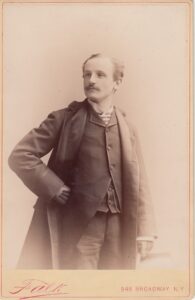
Adolfo Muller photographed in New York c.1886
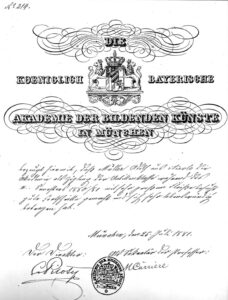
The young Adolfo Müller’s first certificate from the Royal Academy in Munich dated July 1881.
Whilst in Paris in late 1884 he decided to visit the United States. He arrived first in Milwaukee (where there was actually a large Swiss community, but the commission he travelled there to execute proved immediately uncongenial), and then visited Chicago and St. Paul, where he had relatives. In 1885 he went to Baltimore to paint James Cardinal Gibbons for the first time and in 1886 completed a full-length portrait which was given to the Cardinal for his residence after being exhibited at Schaus’s Gallery in New York (missing). At around this time he was travelling all over the eastern United States painting and executed a very large canvas of the Bushkill Falls in Pennsylvania (Von der Heydt Museum, Wuppertal, Germany). Luckily for the artist, his talent for portraiture was soon noticed by the St. Paul railroad builder James. J. Hill, who was to commission or acquire many pictures of himself, his family, his friends and business associates, like his neighbour in St. Paul, Conrad Gotzian (whom the artist painted posthumously in 1887), the Canadian missionary Father Albert Lacombe in 1895, and John Stewart Kennedy, the financier, in 1901.
In the Newark Museum, New Jersey, is a portrait of a little girl dressed in pink called Miss Brandeis which is probably his first commissioned picture made in America (it is signed with a variation of his family name, A. Lombardi-Muller), though a portrait of Father Joseph Fransioli, who was minister to the large influx of Italian-speaking immigrants arriving in New York, today at the Brooklyn Historical Society was possibly completed before this as it is signed Adolph Muller. It would seem that from quite early on he wanted to sign his works in a way that was unique to him, and so portraits between 1886 and 1889 are sometimes signed F. Adolphus Muller, A. Muller-Uri, or Muller d’Uri. By 1890 this was fully anglicized as A. Muller-Ury, the umlaut in his surname being dropped. Some of his later smaller works are signed A M Ury. (It should be noted that as late as 1932, the Swiss-American Historical Society published a book on Swiss-Americans where his name was inaccurately stated as Adolph Felix Muller-Uri.) In 1889 he painted a portrait of John R. Brady a New York Judge which was apparently presented to the American Bar Association. He may have travelled in North Africa in the summer of 1889 after visiting the Exposition Universelle, as he dated a Portrait of a North African man with a Gun (previously known as Portrait of an Arab; Private Collection, London) that year and exhibited a picture called In the Dark Continent at the National Academy of Design in New York at the end of that year (No. 105; lost). In 1890 he completed a second bust-length portrait of Father Joseph Fransioli of Brooklyn (lost).
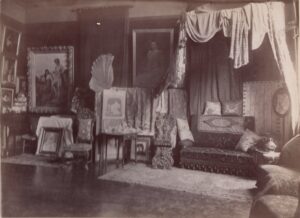
Part of the artist’s studio in the Sherwood Studio Building, 58, West 57th Street, New York, photographed in 1894
His New York studio 1885-1904 was in the Sherwood Studio Building, 58 West 57th Street and 6th Avenue (the building has been long demolished), where he is noted before 1889 in Room C; by 1894 he had a studio (where he eventually hung some Gobelin Tapestries) with a waiting room (both lit by windows) and a bedroom.
Other artists who rented studios in the building in the 1880s were his friend from Munich, Jan Chelminski (who later married the sister of art dealer Roland Knoedler), landscape painter Robert W. Van Boskerck, James Carroll Beckwith, painter and muralist Edwin Howland Blashfield, and painter turned critic Arthur Hoeber, and later artists such as Carle Blenner and portraitist George Burroughs Torrey. He was photographed in his Sherwood studio by artist turned photographer Edwin Scott Bennett (1847-1915) which was exhibited at the annual exhibition of the Society of Amateur Photographers of New York in 1894.
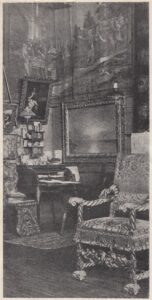
A corner of Muller-Ury’s Sherwood studio as illustrated in Vogue, 26 February 1903. His Gobelin tapestries were his prized possessions, but he had to sell them during the Depression.
For a number of years he commuted between New York and Europe. On 19th May 1892, after the great success of his portraits of Senator Chauncey M. Depew in 1890 (Yale Club of New York City) and Mrs Theodore Havemeyer in 1891 (Preservation Society of Newport County, Rhode Island), he applied for United States citizenship (which he received only on 20th July 1928). It was apparently at this date that he met the young art dealer Joseph Duveen, who was to become a close friend, and after 1891 that he began to be dubbed ‘Painter to the Four Hundred’, referring the élite of New York society in whose circles he socialized.
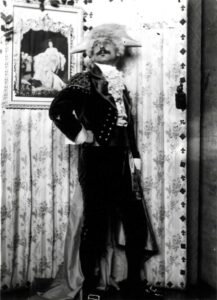
Muller-Ury dressed in his costume for the Bradley Martin Ball in February 1898 which was described as: ‘…a Spanish toreador of the latter part of the 17th century, not in bull fighting costume but in city dress with much white lace frilling on the shirt and a white waistcoat and sash of yellow-ribbed silk; the mantle was lavender color and the wig white; ruffles of lace at throat and wrists.’
He was to be much aided by the Havemeyers, who introduced him to many clients and encouraged many of their friends and relations to sit to him; and also by Louis Benziger (1840-1896), of the Roman Catholic publisher Benziger Brothers, who persuaded many New Yorkers to sit to him and gave him introductions; he remained friendly with his son Bruno Benziger until his death, and indeed Bruno Benziger organized the artist’s burial. As his position in society was essentially that of a gentleman who earned his living by his brush, and creative unmarried ‘European’ men living in New York were considered respectable, acceptable and interesting additions to New York or Newport dinner parties capable of partnering otherwise unaccompanied ladies, he became a considerable social butterfly in the Gilded Age. He was also invited to a number of prominent balls: the infamous Bradley Martin costume ball in February 1898 where he dressed as a Spanish toreador, and perhaps more significantly, the Chinese ball given by Mrs Vanderbilt Belmont in August 1914 at Marble House in Newport, Rhode Island, which is generally considered effectively to end the Gilded Age.
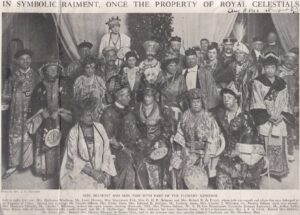
A photograph of guests at the Chinese Ball at Marble House in Newport in August 1914 from the photogravure section of the New York Times. Muller-Ury is at the extreme right.
Almost from his earliest days in New York he had exhibited his pictures in group shows, solo shows or singly, and many established galleries sought to display his work as his reputation increased as the exhibition record (see the page below) reveals; it is fascinating that in March 1897 at the Durand-Ruel Galleries he held his largest solo exhibition to date between shows devoted to the French Impressionist artists Camille Pissarro and Auguste Renoir. The gallery which held most of his one man shows before World War I was that of Knoedler, where he was friends with Roland Knoedler and the Henschel family (he painted portraits of the late Edmund Henschel in the 1890s, and a lively oval of the attractive Ruth Kerr Henschel in 1910).
For three years in the late 1890s he leased the former studio of Pre-Raphaelite artist Herbert Draper at 9 Pembroke Studios in Kensington, London, where he certainly painted portraits of Sir Donald Smith, 1st Baron Strathcona and Mount Royal, and Sir George Stephen, 1st Baron Mount Stephens who were business associates of James J. Hill, of whom he made an etching in London in 1898 which was distributed to Hill’s family and colleagues. According to a letter he wrote to Hill he started the portrait of Consuelo Yznaga, the 8th Duchess of Manchester, in London in 1898, but it is not known if it was ever completed. It was whilst in London in 1899 that he was presented to Edward, Prince of Wales at a Levée at St. James’s Palace and painted a portrait of Dr. Charles-Daniel Bourcart of Basel, the Swiss Minister, the first permanent diplomatic representative of Switzerland in Great Britain (London Embassy).
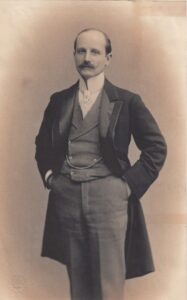
Muller-Ury in high society in the early years of the twentieth century: “Painter to the Four Hundred”.
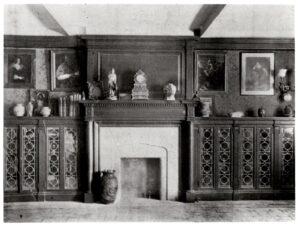
Muller-Ury’s Library at the top of the 1904 Atelier Building (Studio 7FE), 33 West 67th Street, New York.
In 1903 he was one of a group of artists (including married artists Robert and Bessie Vonnoh, Guy Wiggins and Willard L. Metcalf) who invested in a new studio building, the Atelier Building, 33 West 67th Street which was completed in 1905. Muller-Ury lived in the top floor right studio, which was richly appointed and and incorporated a stained glass panel of the Müller coat-of-arms into the window (removed in 1947 and now preserved at the Haus Müller-Lombardi in Hospental, Switzerland). The floors were all inlaid with borders of intarsia, and the smaller windows at the front of the building on 67th Street were given mullions in emulation of Swiss architecture. He moved into the studio in 1904 and remained there until 1947. It must have seemed a good location for the artist as The Swiss Benevolent Society soon purchased a fifty-foot-wide site at 35-37 West 67th Street and erected a new Neo-Gothic style building, The Swiss House, to assist ‘deserving indigent Swiss’ as a temporary home with medical attendance for both men and women on the site (it closed in 1991 and is now the property of CUNY.)
Muller-Ury’s style from the time he arrived in New York in late 1884 until 1925 is essentially that of academic realism. Early portraits like that of Father Joseph Fransioli in Brooklyn and Miss Brandeis in Newark technically reflect his Munich training, are highly coloured and set against dark backgrounds, but the positioning of the figures is tentative if not awkward; however, his portraits in the 1890s indicate his work had gained in confidence and power, reflecting Gilded Age notions of grandeur. His works from the time he painted Senator Chauncey M. Depew in 1890 to the time he painted J. Pierpoint Morgan in 1904, give substance to the comment in the National Cyclopedia of American Biography (1896) that his portraits were ‘after those of Velasquez, Rembrandt and Titian. His portraits are remarkable for their boldness and likeness to life’.
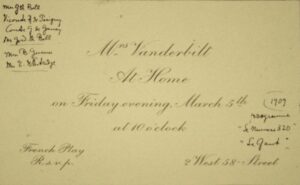
Muller-Ury’s annotated invitation to a French Play performed in March 1909 at Mrs Vanderbilt’s palatial residence at 1 West 58th Street, New York (artist’s papers)
Around 1901, when a lighter, Anglo-French, and Georgian taste became fashionable, his society portraits emulate Gainsborough, Reynolds, Hoppner and Romney, even some of the 18th century French masters, the palette lighter, frequently oval, and the poses sometimes derivative. Between 1904 to 1914 he painted his most accomplished portraits, and this is probably his most successful period. After World War I his pictures remain bold and lifelike, but after his move to California in 1924–25 he often uses an impressionistic technique, derived from Rembrandt and the French Impressionists.
The catalogue lists many of his prominent sitters, but mention must be made of the several portraits he made from 1904 of the financier and collector J. Pierpont Morgan, and the fact that he received a commission from a wealthy Roman Catholic from Philadelphia to paint Pope Pius X in 1907. In this commission he was aided by the Rector of the Pontifical North American College, Monsignor Thomas Kennedy who became a friend and whom he was to paint twice. He painted two more versions of his portrait of Pope Pius X in 1908, and 1911, and other smaller versions were finished during these years. The success of his portraits of Pope Pius X led, in 1909, to a commission to paint Kaiser Wilhelm II of Germany – the history of which the present editor has documented in an article in the British Art Journal – and in 1916 to paint the second Mrs Woodrow Wilson as a wedding gift from her husband’s friend Colonel Edward M. House, whose wife, Loulie, the artist also painted. The following year he painted a portrait of President Wilson himself, perhaps, like that of the Kaiser, one of his better documented pictures, and at least two more are known. After World War 1, he painted two portraits of Pope Benedict XV and in 1922 several portraits of Pope Pius XI, for which he was created a Knight of St Gregory the Great.
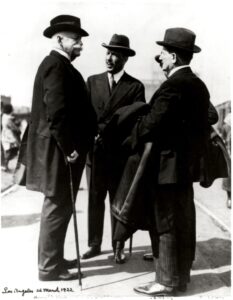
Henry E. Huntington, Sir Joseph Duveen, Parish Watson and Adolfo Muller-Ury at Los Angeles Railroad station, March 1922
In March 1922 he traveled with his friend Sir Joseph Duveen (later Lord Duveen) to California for the first time, in order that Duveen could deliver to bibliophile and art collector Henry E. Huntington Gainsborough’s famous picture The Blue Boy which Huntington had bought the previous year. Duveen had told the artist that Huntington would commission a portrait of himself. But in this the artist was immediately disappointed. Muller-Ury liked California and after painting Archbishop Edward Hanna in San Francisco in 1923, and painting the eldest daughter of businessman Herbert Fleischhacker in 1924 (again in San Francisco) he decided that year to erect a studio near Huntington’s estate, on land he acquired from the Huntington Land Improvement Company.
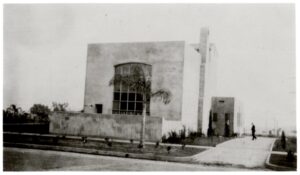
The earliest photograph of Muller-Ury’s recently completed San Marino studio facing north onto Monterey Road, 1925.
This was a pioneering step, but he was aware that many wealthy living on the east coast had begun to escape the winters by moving to the west coast, and that the proximity of the Huntington collection would attract sitters to him. The studio he built was at the corner of Monterey and Shenandoah Roads in San Marino (architect Carleton Winslow), in the fashionable Spanish style with a green tiled roof, a strongroom in the basement, dining room and staff quarters on the ground floor, a bedroom for himself with dressing room and bathroom, and a guest bedroom and bathroom above, and in the studio a balcony at the south end accessible by the main staircase (which rose through the height of the building to a sun deck), and an enormous north-facing window to give him cold light suitable for painting. He placed the Müller coat-of-arms on the east frontage of the studio, where it may be found today. 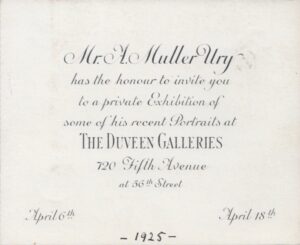 The gardens were extensively planted with many varieties of roses including Radiance, Columbia, Rose Marie, Irish Charm, Imperial Potentate and American Beauty which he painted into his canvases depicting the Morgan porcelains begun in New York. Duveen built a bungalow next door to the artist on Shenandoah Road, but seems to have quickly sold it after the death of his client Henry E. Huntington in 1927.
The gardens were extensively planted with many varieties of roses including Radiance, Columbia, Rose Marie, Irish Charm, Imperial Potentate and American Beauty which he painted into his canvases depicting the Morgan porcelains begun in New York. Duveen built a bungalow next door to the artist on Shenandoah Road, but seems to have quickly sold it after the death of his client Henry E. Huntington in 1927.
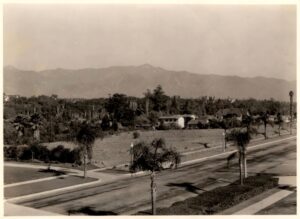
A 1925 view from the sun deck of Muller-Ury’s San Marino studio towards the San Gabriel Mountains with empty building lots on Monterey Road. Huntington’s mansion is just visible at left.
It was whilst Muller-Ury was building and furnishing this studio on the West Coast that he held his first one man show since 1913 in Duveen’s sumptuous gallery on New York’s Fifth Avenue. This exhibition, apart from two of his recent Papal portraits, and the recently completed three-quarter portrait of Cardinal Patrick Hayes – considered by American Art News to be the masterpiece of the show (which survives tragically cut down) – included two portraits of two of Duveen’s most important clients both of whom died over a decade earlier in 1913, Benjamin Altman and J. Pierpont Morgan, as well as the bust length portrait the artist had painted of Duveen’s daughter Dorothy, exhibited as ‘Miss X’.
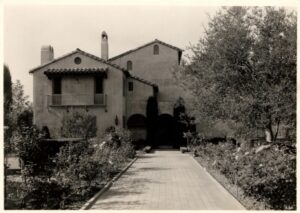
Muller-Ury’s San Marino studio from the east side facing Shenandoah Road, circa 1926
In 1926, Muller-Ury seems to have begun from a photograph a portrait of Henry E. Huntington standing (Howard Huntington Memorial Hospital, Pasadena) and a seated one (which was engraved by Witherspoon) as well as another smaller seated version which was acquired by John and Elizabeth Huntington Metcalf; his portrait of their daughter Mary Brockway Metcalf was for some years hanging in the lobby to the office of the Director of the Huntington Library on loan from Edwards Metcalf.
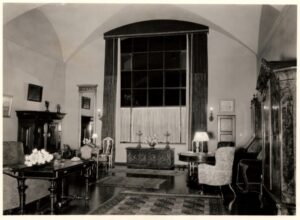
A view of the interior of Muller-Ury’s San Marino studio facing north.
It was in San Marino during the following years, that Muller-Ury executed portraits of the following sitters: Henry Mauris Robinson, the diplomat; Anita Baldwin (daughter of Lucky Baldwin of Arcadia, full-length; Los Angeles County Arboretum & Botanic Garden); Maurice DeMond, founder of the Breakfast Club then in Griffiths Park; Mrs Carrie Ada Lawless, wife of William J. Lawless, the Mayor of Sierra Madre 1928-1929 (Sierre Madre Women’s Club); and President Rufus B. Von Kleinsmid (1931) of the University of Southern California (three-quarter length; deaccessioned by the university in the 1980s).
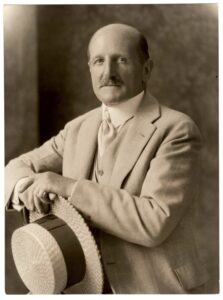
Muller-Ury photographed by Sergis Albert, Hollywood
In 1930, the year he travelled to Rome again to paint Pope Pius XI, for which the following year he was ennobled as a Roman Count, Muller-Ury painted the former Miss Gladys Quarré of San Francisco (then Mrs Frederick Peabody of Montecito, Santa Barbara); later she became known as Gladys Quarré Knapp, a socialite and friend of many Hollywood actors. He also painted a large allegorical work entitled The Spirit of California a version of which was acquired by a prominent art collector called Fred Elbridge Keeler (lost). Muller-Ury’s pioneering decision to move his portrait practice to the west coast faltered in the early 1930s, and with regret he abandoned the California studio on September 3, 1933, after several clients did not pay him and he had had to sue the wife of an actor friend of film star Douglas Fairbanks (Mrs. Norman Kerry; he bought the picture back at an auction ordered by the judge who ruled against Mrs Kerry). The irony of his move back to New York was that, had he stayed longer, he would probably have received commissions to paint some of the burgeoning ranks of Hollywood film stars, but he could not afford the cost of running his studio in the midst of the depression without the certainty of getting portrait commissions. The house was let to friends until in January 1943 the artist was offered $60 per month for it to be used by the Red Cross, who did so for the remainder of the Second World War. He only sold the property in January 1947 (according to a letter to his sister Lina) for about half its value because nobody was prepared at that time to buy a property where most rooms were comparatively small except for the enormous studio.
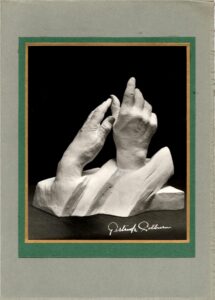
The cover of the card showing Gertrude Colburn’s cast of Muller-Ury’s hands.
After his return from California he settled permanently back in his New York studio. Portrait commissions in the middle of the Depression were becoming fewer and he spent much time painting still lifes and experimenting with forms of impressionism. In 1936 he travelled again to Europe and recorded in his diary that Duveen had met Andrew Mellon in London and was negotiating the sale of a large collection old masters to him because Duveen wanted to retire. In early August he revisited Munich and saw the Brown House and Hitler’s residence, in Andermatt that month painted the portrait of his kinsman Isidor Meyer, and on September 4 visited Giuseppe Motta in Berne. In November he attended a dinner at Duveen’s New York mansion for the Director of the National Gallery in London, Sir Kenneth Clark, at which most of Duveen’s most important clients were present. He may have been in Europe in the summer of 1937 but was certainly there in 1938 when he painted a large portrait of Motta for his home town of Bellinzona (Archivio Cantonale). In 1937 he painted a portrait of the elderly Ellen Dunlap Hopkins, founder of the New York School of Applied Design for Women, which he presented to the School in 1938 (Private collection, Brooklyn). Around this time his hands were cast in plaster by the ballet dancer-turned-sculptor Gertrude Colburn, who wrote a eulogistic poem in the artist’s honour (a photograph of the poem is at the bottom of the EXHIBITIONS page below).
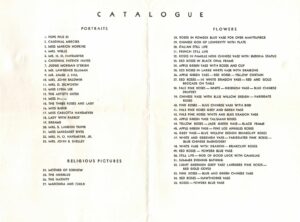
The handlist for the large 1937 Wildenstein show.
Although the artist had been absent for nearly ten years from New York, in 1937 the dealer Wildenstein gave him his largest ever one-man show filling their recently completed Upper East side gallery, at which, to give the artist much needed publicity, his friend Lord Duveen purchased a picture for stock; Barclay Beekman reported in the New York Mirror, April 21, 1937, that ‘…One painting of a Buddha and a green-glazed Chinese plate was purchased almost immediately after the exhibition opened by Sir Joseph Duveen.’
He painted his friend Archbishop Spellman of New York twice in 1940 – one is at St Joseph’s Seminary, Yonkers and the other was presented by Manhattan College to Fordham University in 1941 (who appear to have lost the work) – and again in 1942; he also painted Archbishop Rummell of New Orleans (1943).
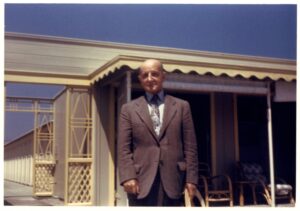
Muller-Ury in the early 1940s
In 1940, he also painted for the first time the then famous radio soprano, Jessica Dragonette (Georgian Court University, New Jersey) and made several portraits of her during the next few years, his last portrait in 1946 depicting her bust-length in a gold fez. In 1941 he produced a portrait of her sister Rosalinda (always called Nadea) Loftus looking over her shoulder. He also painted Dragonette’s colleague Fred Mitchell, and several portraits of her friends and acquaintances. In 1942, at age 80, he painted a three quarter length seated portrait of Mrs George H. Ingalls (née Katharine Davis Hinkle; Private Collection, London), whose late husband, a descendant of one of the founder families of America who had left Lincolnshire in 1628, had been a Vice-President of the New York Central Railroad. Jessica and her sister arranged a retrospective exhibition of Muller-Ury’s works at French & Co., New York, in the Spring of 1947 for Italian War Relief, getting portraits out of his studio racks and borrowing several from his older clients’ families; there was also a selection for sale of his final impressionistic rose paintings which the French gallery’s connoisseur Mitchell Samuels, and his son Spencer, who arranged the pictures in the gallery, very much admired.
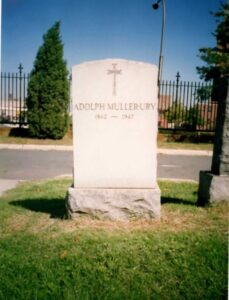
Muller-Ury was interred in New Calvary Cemetery, Queens, New York, where his gravestone is marked simply, if incorrectly, ‘ADOLPH MULLER-URY 1862-1947’. The grave is located at Section 10, Plot 445, Grave No. 8.
Muller-Ury died, apparently of cancer, on July 6, 1947, at the Lenox Hill Hospital, New York and is buried in New Calvary Cemetery, Queens, New York. On Thursday, July 10, 1947, a Requiem Mass was held for the artist in St. Patrick’s Cathedral by Cardinal Spellman.
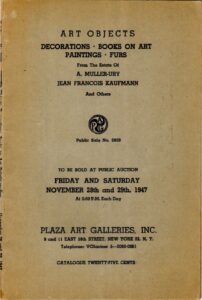
The first of the Plaza Art Galleries sale catalogues in which Muller-Ury’s studio contents were sold.
After his death his youngest brother, Otto Müller, travelled to New York to settle his estate. Most of his studio contents, and many of his pictures, were sold at auction. Jessica Dragonette recorded in her 1951 autobiography that she ‘…could not bear the ruthless disposition of his effects after his death…His books, furniture, pictures, brocades and velvets with which he covered his portraits were carelessly thrown about. Dealers only interested in the handsome frames denuded the pictures.’ There were two sales at the Plaza Art Galleries, 28 and 29 November 1947 (No. 2809) and 5 December 1947 (No. 2813), including his oil sketch of Kaiser Wilhelm II of Germany, and the oval portrait of opera singer, Lina Cavalieri which Dragonette bought and which her husband eventually presented to the Metropolitan Opera House. A number of pictures were returned to Switzerland, and the artist’s youngest sister Lina Müller gave a couple of portraits of Popes and a Cardinal to the Historisches Museum von Uri in Altdorf, but most of the smaller ones Otto brought back were briefly deposited in the Winterthur Museum, and family members living in Switzerland were invited by Otto and Lina Müller to select a portrait and a rose painting. The several that were left over, unwanted by family members, were collected together by Iva Müller, the artist’s niece, and hung for many years in a family property which once stood in the grounds of the Grand Hotel Bellevue in Andermatt (the hotel was demolished in 1986, and the Hotel Chedi now stands on the site).
Pictures still occasionally surface at auction and sell for small or moderate sums, but a great many remain today undocumented in institutions, or survive in private collections, probably with the descendants of the original sitter or owners, their creator largely forgotten. It is hoped that this research website will encourage research into the artist’s career and many more of his pictures will be brought to light enabling scholars to return the artist to his rightful place as one of the prominent portrait painters in the American Gilded Age and Progressive Era.
BIBLIOGRAPHY
- Lyman Horace Weeks, Prominent Families of New York, being an account in biographical form of individuals and families distinguished as representatives of the social, professional and civic life of New York City (1897), p. 422.
- Mitchell C. Harrison (compiler), New York State’s Prominent and Progressive Men: An Encyclopaedia of Contemporaneous Biography, Volume 3, New York, 1902, p. 243.
- S.E.L. (Leisha), “A Successful Portrait Painter”, Town & Country, New York, August 22, 1903, pp. 19–21.
- Jerry Cotter, “Muller-Ury: Portraitist”, The Sign, Vol. 27, No. 1, August 1947.
- Jessica Dragonette, Faith is a Song: The Odyssey of an American Artist, New York, 1951.
- Geraldine Norman, ‘The Artist Time Forgot’, The Independent, London, December 16, 1989.
- Stephen Conrad, “Re-introducing Adolfo Muller-Ury (1862-1947): The artist, two dealers, four counts and the Kaiser: a hitherto unknown episode in international art history” in The British Art Journal, Vol. 4, No. 2, (2003) pp. 57-65.
————————————————————————————————–
* This biographical sketch is adapted, corrected and expanded from the editor’s work on the artist’s Wikipedia entry to which he contributed from 2006.

